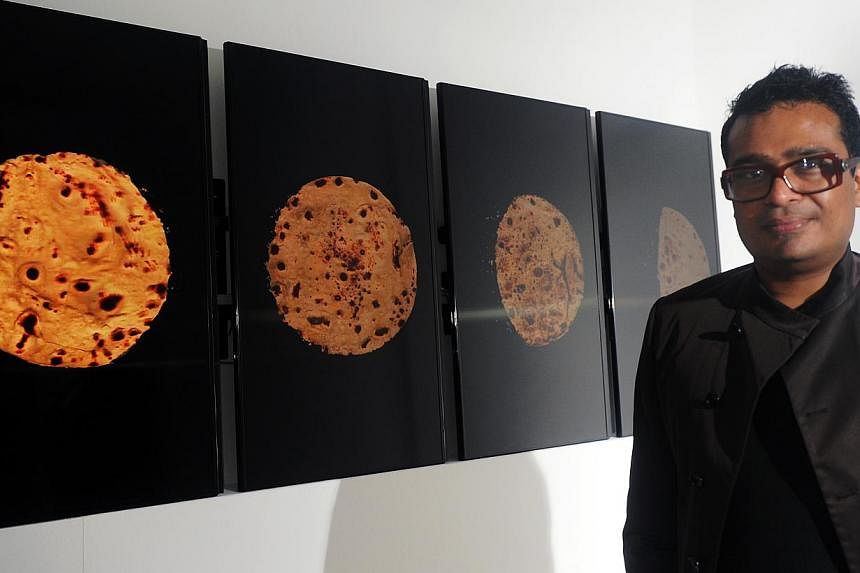At a time when most blockbuster biennales and visual arts events are turning out to be a march of celebrities, champagne and clothes, India's recently concluded, no-frills, Kochi-Muziris Biennale puts the art firmly back in the spotlight.
In an interview with Life!, its artistic director Jitish Kallat had spoken of the immense challenges of holding India's only contemporary arts biennale together with fellow artists Bose Krishnamachari and Riyas Komu.
Funding, or the lack of it, was right up there. It is one thing to hear of funding woes and quite another to experience it.
To put it mildly, for someone perfectly accustomed to Singapore's air-conditioned comforts, nothing prepares you for Kochi - a coastal town in south-western Kerala - in March.
When I started at the main venue, the former spice store Aspinwall, the challenges Kallat spoke about became immediately apparent.
The large sea-facing heritage property in Fort Kochi was the main biennale venue. Sixty nine of the 100 works by 94 artists from 30 countries were presented here.
In extremely raw and often edgy spaces, with plaster on the walls peeling in some spots, contemporary art as we know it now was being presented. The heat was oppressive and if you needed respite, a sole standing fan provided the only ventilation.
Suddenly, Singapore's 2013 biennale outing at the Old Kallang Airport - which drew flak for the lack of ventilation and air-conditioning in some of its spaces - started evoking visions of luxury. It took a while for my body to adjust to the sweat trickling from head to toe.
Somehow, in the oppressiveness of the heat minus the dust, this biennale made me imagine. It made me imagine many things as I stepped into each of those rooms, looked at each of those walls and did my rounds of this and other venues, such as another waterfront heritage property, Pepper House.
What I saw were several fresh and cutting-edge artworks that crept under my skin.
Yes, there was no escaping rockstar contemporary art names such as Belgian conceptual artists Wim Delvoye and Hans Op de Beeck; famed American design duo Charles and Ray Eames' iconic 1977 film titled Powers Of Ten exploring man's place in an infinitely complex universe; Japanese multimedia artist, musician and activist Yoko Ono's Earth Piece featuring postcards from 1963 and 1999; and Mumbai-born British sculptor Anish Kapoor's stunning water vortex titled Descension.
The real surprises, though, were from names I had never heard of, in works I had never previously seen.
In one small stuffy room, I gazed at a stunning sculptural installation titled Artha, or Meaning. It was only when I walked out of the room and read the curator's statement that I realised this piece by young Jaipur-based sculptor Prashant Pandey was made out of 10,000 discarded slides containing blood drawn from a large number of people, including the artist himself. I went back into the room and stood there transfixed for the next 15 minutes, thinking of visceral rejects and how they can help us make strange sort of connections.
In another room, another young artist, Vadodara- based Lavanya Mani impressed with her use of textiles as well as the use of India's rich textile traditions to present Travelers Tales - Blueprints. The 2014 work made using natural dyes and pigment paint on cotton fabric was one of the most colourful and vibrant works I saw. Evoking sails of ships, it helped recreate journeys of travel and the subsequent narratives that were shaped by that very travel.
What was fascinating was Mani's use of Kalamkari, a centuries-old textile painting technique from India, which uses only natural dyes. These textiles were so popular in the 17th century that the French and English governments outlawed them to protect their own local mills.
That was one of the most poignant responses to the biennale's theme, Whorled Explorations - an invitation by Kallat to fellow artists to look at the city's history from its discovery in the 15th century.
Kochi was a melting pot of religions and a centre of the spice trade around the Arabian Sea.
"I wanted the artists to look at Kochi as a viewing device, to go back to the days of early sailors and stargazers and through it, to somehow make sense of the world we are in," said Kallat and, in many ways, they did.
Mumbai-based artist Neha Choksi's 13.35-minute video work Iceboat was particularly fitting in this context. I ended up watching it thrice, drawn by the sheer mesmeric effect of the artist's flowing fabric and persistent rowing of a boat till it melted. Viewed in Kochi, with the sea by its side, it somehow made me think of the inevitability of endings and perhaps even doomed voyages to this city.
Many visitors engaged with Choksi's work, though the greatest engagement on the closing weekend seemed to be with Singapore artist Ho Tzu Nyen's Pythagoras (2013).
The dramatic video work presents images of veils with a voice playing in the background and is inspired by some of the ideas and thoughts of the titular Greek mathematician.
While in most of the other rooms people would leave after watching a bit of the work, all the seats were full for Pythagoras and people had even made room for themselves on the floor.
Within a few minutes, it was apparent why. The room felt like the only space cool enough in the complex - many of the artists had to get their own funding to participate in this biennale and the installation of Ho's work came complete with what definitely felt like air-conditioning, though it could have been a water cooler at work.
I overheard someone in the room say gratefully, "In Singapore, the air-conditioning always works", and left with a smile on my face.
In the end, the battle with the heat proved inconsequential.
This "people's biennale", as it was called, drew a record 500,000 visitors over 108 days. Families packed the closing weekend. The first edition had 450,000 visitors, which brings it fairly close to the world's top contemporary art event, the Venice Biennale, in terms of visitor numbers. Italy's Venice Biennale, which runs for twice as long, had about 475,000 visitors in its 2013 edition.
Like some key Asian art events such as the Dhaka Art Summit in Bangladesh and ArtJog in Yogyakarta - the artistic and cultural capital of Indonesia - there was an intensity and edginess in much of the works I saw in Kochi.
Sure, each of these events lacks the glitz factor or even many of the creature comforts we sometimes seek, but that is what art should be. It should sometimes knock you straight out of your comfort zone and make you think.


